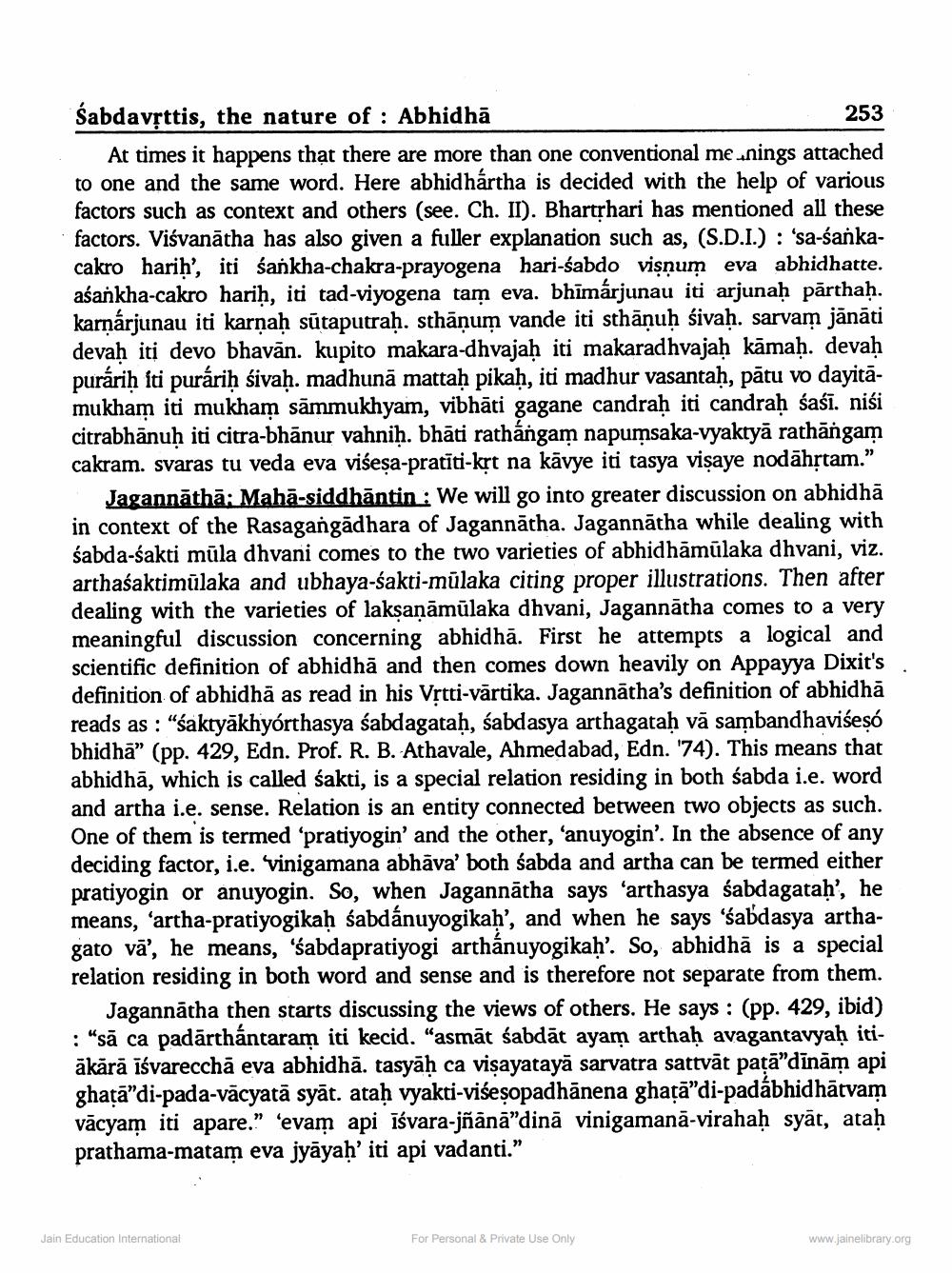________________
Śabdavṛttis, the nature of : Abhidhā
253 At times it happens that there are more than one conventional meunings attached to one and the same word. Here abhidhártha is decided with the help of various factors such as context and others (see. Ch. II). Bhartshari has mentioned all these factors. Viśvanātha has also given a fuller explanation such as, (S.D.I.) : 'sa-śankacakro harih', iti sankha-chakra-prayogena hari-sabdo visnum eva abhidhatte. aśankha-cakro hariḥ, iti tad-viyogena tam eva. bhīmárjunau iti arjunaḥ pārthaḥ. karņárjunau iti karṇaḥ sūtaputraḥ. sthāņum vande iti sthāņuḥ śivaḥ. sarvam jānāti devaḥ iti devo bhavān. kupito makara-dhvajaḥ iti makaradhvajaḥ kāmaḥ. devaḥ puráriḥ iti puráriḥ śivah. madhunā mattah pikah, iti madhur vasantaḥ, pātu vo dayitāmukham iti mukham sammukhyam, vibhāti gagane candraḥ iti candraḥ śaśī. nisi citrabhānuh iti citra-bhānur vahnih. bhāti rathangam napumsaka-vyaktya rathangam
svaras tu veda eva viấesa-pratīti-krt na kāvye iti tasya visaye nodāhstam." Jagannāthā: Mahā-siddhāntin : We will go into greater discussion on abhidh, in context of the Rasagangadhara of Jagannātha. Jagannātha while dealing with śabda-sakti mūla dhvani comes to the two varieties of abhidhāmülaka dhvani, viz. arthaśaktimülaka and ubhaya-sakti-mülaka citing proper illustrations. Then after dealing with the varieties of laksanāmülaka dhvani, Jagannātha comes to a very meaningful discussion concerning abhidhā. First he attempts a logical and scientific definition of abhidhā and then comes down heavily on Appayya Dixit's definition of abhidhā as read in his Vrtti-vārtika. Jagannātha's definition of abhidh, reads as : “śaktyākhyórthasya śabdagataḥ, śabdasya arthagataḥ vā sambandhaviśesó bhidhā” (pp. 429, Edn. Prof. R. B. Athavale, Ahmedabad, Edn. '74). This means that abhidhā, which is called sakti, is a special relation residing in both sabda i.e. word and artha i.e. sense. Relation is an entity connected between two objects as such. One of them is termed 'pratiyogin' and the other, 'anuyogin'. In the absence of any deciding factor, i.e. vinigamana abhāva' both śabda and artha can be termed either pratiyogin or anuyogin. So, when Jagannātha says 'arthasya śabdagatah', he means, 'artha-pratiyogikaḥ śabdanuyogikah', and when he says 'sabdasya arthagato vā', he means, 'sabdapratiyogi arthánuyogikah. So, abhidhā is a special relation residing in both word and sense and is therefore not separate from them.
Jagannātha then starts discussing the views of others. He says : (pp. 429, ibid) : "sā ca padārthántaram iti kecid. “asmāt sabdāt ayam arthaḥ avagantavyaḥ itiäkārā īśvarecchā eva abhidhā. tasyāḥ ca visayatayā sarvatra sattvāt pațā"dīnām api ghatā"di-pada-vācyatā syāt. ataḥ vyakti-viśesopadhānena ghatā"di-padábhidhātvam vācyam iti apare.” 'evam api īśvara-jñānā”dinā vinigamanā-virahaḥ syāt, ataḥ prathama-matam eva jyāyaḥ' iti api vadanti."
Jain Education International
For Personal & Private Use Only
www.jainelibrary.org




